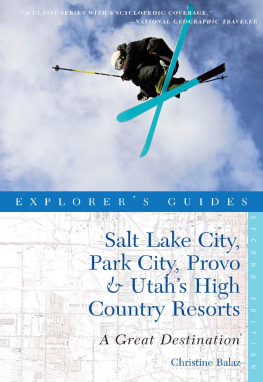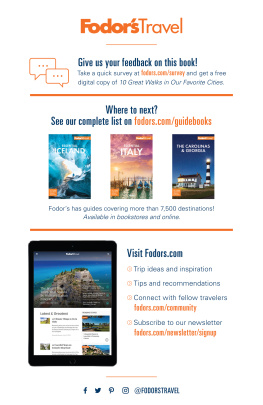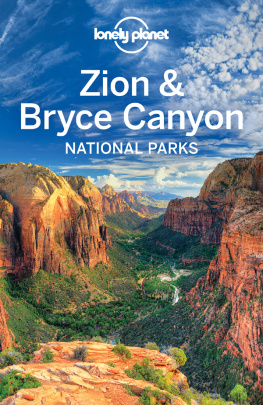
EXPLORERS GUIDES
Zion & Bryce Canyon

Copyright 2012 by Christine Balaz
All rights reserved. No part of this book may be reproduced in any form or by any electronic or mechanical means including information storage and retrieval systems without permission in writing from the publisher, except by a reviewer, who may quote brief passages.
Interior photographs by the author unless otherwise specified
Maps by Erin Greb Cartography, The Countryman Press
Book design by Joanna Bodenweber
Composition by Eugenie S. Delaney
Explorers Guide Zion & Bryce Canyon: A Great Destination
978-1-58157-143-1
Published by The Countryman Press, P.O. Box 748, Woodstock, VT 05091
Distributed by W. W. Norton & Company, Inc., 500 Fifth Avenue, New York, NY 10110
Printed in the United States of America
10 9 8 7 6 5 4 3 2 1

Contents
MAPS

Though tall, the broad Boulder Mountain Plateau has no distinct peaks to speak of.
Introduction
IMAGINE A TRIP TO UTAH. What do you expect to see? Salt Lake City? Moab? Park City? The Mormon Temple? Or perhaps you picture Utahs wilderness. For scenery, Utah is one of the most well-endowed states in the United States. And not surprisingly, many people travel to Utah expressly to experience its spectacular and varied wilds, the most unique and best preserved of which is showcased within the boundaries of its numerous national parks.
Utah has 5 national parks in all6 if you count Monument Valley Tribal Park. Or 7, if you count the 1.9-million-acre Grand StaircaseEscalante National Monument (GSENM). In addition to Zion, Bryce Canyon, Arches, Canyonlands, and Capitol Reef national parks, Utah also contains 45 state parks and 8 national monuments scattered across its 84,899 square miles of diverse terrain. Many of these are situated on national park-grade territory, with incredible views and clean, well-maintained facilities.
Utahs national parks share a common theme of exposed sandstone and the wild shapes that nature carves into it with her tectonic powers of uplift and subduction and erosive powers of wind and water. The Colorado Plateau, which dominates the states southern half, has been so radically deformed by these powers that it has transformed into a giant sandstone sculpture garden, with each of Utahs parks enclosing a distinct variation on theme and medium.
Zion National Park, with its sheer, 2,500-foot sandstone walls, showcases the amazingly solid and smooth features of Zion Canyons Navajo sandstone, exposed dramatically by the waters of the Virgin River. The Colorado and Green rivers 150 miles to the east slice deeply into the Wingate and Cedar Mesa strata of Canyonlands, giving this park its soaring buttes and dramatic rock needles. The main attraction of Bryce Canyon and Cedar Breaks is the loose, brightly oxidized mud and crumbling layers that readily yield to erosive forces. These areas highlight the exposed rainbows of these subterranean strata hiding beneath the Paunsaugunt Plateau. And there isnt a person in the world who doesnt know about the Entrada sandstone windows of Arches National Park. With more than 2,000 of these registered formations greater than 3 feet in diameter, this park contains the densest collection of natural arches and windows in the world.

The Parade of Elephants, in the windows section of Arches, as viewed from the south.
David Sjquist
Beyond the national parks and their emblematic landforms, there are dozens of state parks that offer similarly dramatic vistas and opportunities for outdoor recreation. Less famous than their national peers, these parks have a simpler infrastructure and are less crowded, allowing for a much freer, less structured exploration of natures beauty. One of Utahs biggest and best nonnational park areas is GSENM. This enormous 1.9-million-acre protected area offers vast stretches of slot canyons, hiking, mountain biking, petroglyphs, ruins, and miles upon miles of roads and trails leading into its wilds, offering unlimited exploration. Boulder Mountain, a massive and broad bulge north of Boulder, Utah, offers a high aspen- and evergreen-forested landscape in the Dixie National Forest. Covered in lakes, streams, and campsites, this nearby plateau presents a completely separate climate and set of opportunities than the nearby GSENM.
Among southern Utahs best (or most famous) state parks is Kodachrome Basin, quite near to Bryce Canyon National Park and not entirely unlike Monument Valley. Snow Canyon, conveniently just outside St. George and very near Zion National Park, intimates Nevadas Red Rock Canyon, with its bright orange color schemes and gently rounded sandstone domes. Other worthy destinations on the list include Goblin Valley near Arches, Petrified Forest outside Escalante, and Coral Pink Sand Dunes on the Arizona border.
These state parks offer a supplement to the national parks tour, exhibiting yet other, bite-size vistas and historical sites distinct from nearby areas. Typically smaller and only moderately developed, these cost less to enter than the national parks. Dead Horse Point State Park showcases an extremely small but beautiful peninsula of land teetering over the Colorado River, 2,000 feet below. Additionally, this park contains a new and well-built trail system for mountain bikers of all levels. Snow Canyon State Park, northwest of St. George, offers clean facilities, beautiful hiking trails, camping, and multipitch rock climbing. Anasazi State Park displays the ruins and artifacts left behind by indigenous peoples, illustrating the history of a culture that left behind more than one hundred structures on this site between 1160 and 1235 A.D. And different still, the Frontier Homestead near Cedar City depicts the lives of early Mormon pioneers sent by Brigham Young to colonize southern Utah in 1850. These are just a sampling of Utahs diverse, state-run parks.
Given Utahs desert climate and hot summers, it may come as a surprise to you that its prime park-visiting season falls outside the winter months. In fact, most of its parks are typically best visited in late spring or early fallwith some areas like Cedar Breaks National Monument even being unreachable during the snowy season. Because of its high elevation, Utahs desert is vulnerable to the elements. It can be covered in snow one day and bake under intense sun the next. In terms of cold weather and snow accumulation, the most extreme and commonly visited location detailed in this book is Cedar Breaks National Monument. With an elevation nearly 2 miles above sea level, the monuments roads can remain utterly buried under snow into early June, despite plowing efforts. Sometimes it remains closed even through the middle of this month.
As a rule of thumb, the St. George area of Utah typically is the states warmest. With its far southern location and relatively low elevation, it enjoys comfortable daytime temperatures, sometimes even in Januarydepending on the weather, of course. However, nearby Zion National Park stays cooler and more susceptible to inclement weather because of its mountainous topography and the shading of its deep and narrow canyons.
Next page











